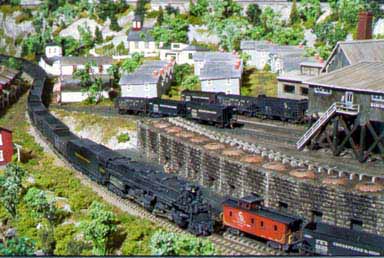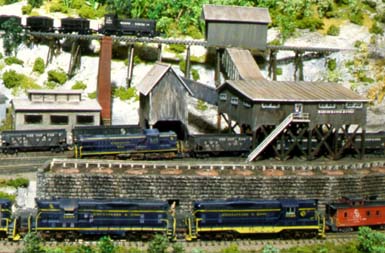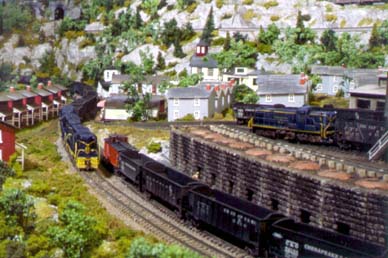Design
John's plan conveys the feel of a bustling coal town deep in the New River of WV. It includes many of the prototypical features and structures in Sewell but does not slavishly follow the prototypical track plan. To create a feeling of isolation he wanted to include both sides of the valley. To do this and still keep the module a reasonable size, he had to model the river narrower than it actually is. The achieved effect is worth the compromise.
John ran tracks run on both sides of the river creating an opportunity for numerous bridges. The plan also includes a separate loop of track for the Mann's Creek Railroad and higher up an extension of the High line used by some of the other New River Subdivision modular modellers. John built a two foot optional section that closes the high line loop. Thus the two tracks on the high line form an elongated oval. On this loop he can operate two trains simultaneously on one controller. They start from opposite ends of the loop and progress halfway where they stop in a dead section. A timer starts them again automatically.
Structures
The Sewell module is full of unique structures John scratchbuilt or had cast from masters he made. All are based on actual prototypes, but not necessarily found in Sewell. John scratchbuilt the tipple and screening plant using pictures from the Park Service booklet called, "Sewell, A New River Community" as reference. He used the same book for reference photos of the C&O Victorian-style depot with octagonal telegraph tower. 
Next to that station are scratchbuilt models of the Pocahontas Collieries Company store at Premier, WV, the saloon of the Superior Pocahontas Coal Co in Davy, WV and the Elverton Company Store, Post Office and mine headquarters for the Branch Coal and Coke Company.
Another scratchbuilt structure is the Union Church, originally built in 1921. Here travelling preachers served the ministry, occasionally performing baptisms either in the New River or in the swimming hole on Mann's Creek. John duplicated a baptism scene on the left side of the module that was inspired from a photograph on the cover of the National Park Service booklet on the New River.
To the right of the Church is the two room, two teacher, kindergarten thorough eight grade school built in Sewell in 1928. High school students had to ride the train some 30-40 miles one way each day to reach their school.
Scattered about the module are 18 grey and 9 red company houses, and 12 coke oven workers houses all based on prototype structures. John built masters in such as way that individual pieces could be cast. These consisted of front, back, two sides, two roofs, four foundation pieces and two DPM chimneys. His good friend and fellow Valley NTRAK member, Jim Dahl, made molds for all the parts and cast 39 sets for John to assemble.
John kitbashed the coke ovens using fronts made from Woodland Scenics cut stone retaining wall. He carved the top stone work, cut in an opening for a door and a lintel. The top piece is a rectangular base the width of the oven, on which he placed a very thin slice off the top of a "Mr Plaster" beehive coke oven. Then he placed three concrete piers along the back in which he cut notches for Z gauge rail. A scratchbuilt Larry car rides these rails to fill the beehives through chutes and openings in the top of the ovens. Originally the Larries were pulled by donkeys and then later by electric motors powered off an overhead trolley wire. Jim cast 30 sets and John set them in place on wood platforms shaped to the contour of the tracks. Next, John filled fine black coal ballast around the top edges of the oven and the concrete piers. Finally he used superglue to hold the Z gauge rail in place. Jim also cast five log cabins, that John located in the woods, and a pair of right and left tapered stone bridge piers. These were very versatile as they could be paired together to make bridge pier or used alone as abutment.
John scratchbuilt all the bridges. John intentionally built the double track high line arch bridge over Mann's Creek with an extra "busy "design to draw one's eye away from the Mann's Creek RR tracks that pass through the backboard of the module near this point.
Construction techniques
John used conventional 1x4 lumber for the module frame and quarter inch Luan plywood subroadbed. John put Vinylbed roadbed under Peco code 80 track, switches and accessories.
He fashioned the scenery base by using a saw, knife and wood rasp to roughly shape Styrofoam. He then covered the Styrofoam with one or two layers of Woodland Scenic plaster gauze. To create rock outcrops he used Plaster of Paris painted on the gauze with a disposable wet brush.
To simulate water John used Envirotex two-part resin. To achieve the rough surface, he prodded the resin surface with a disposable stick just before the resin set. Where the river widens at the baptism scene, John let the Envirotex cure to a fairly smooth surface, as he didn't think the good Christians would be testing their faith in a raging river.
Rocks along the riverbank came from material taken from the New River. John smashed these samples with a 2 lb. hammer on a concrete floor, gathered and sifted progressively through a collection of plastic butter containers with holes drilled in their bottoms starting at 1/8' and working up to 1" in 1/8" increments.
John's wife Jacqueline did all the ground cover, trees, and painted the backboards. She used Woodland Scenic grass and foam clusters where appropriate. The bulk of the trees she made from a variety of natural plants. These plants are usually sold in garden center or craft stores that have variety of dried plants for floral arrangements.
John really puts his heart and soul into building a module and always seeks challenges. But to him it's worth all the effort when a visitor points to the module and says, "I was baptised in the New River like that." John work was awarded the Most Popular Module at the 1998 N Scale East Convention in Orlando, FL and First Place, Module at the 1998 NMRA National Convention in Kansas City.
John is indebted to his wife Jacqueline and friend Jim Dahl. He could not have completed this module without their tireless efforts.
See John's Latest Module Kanawha Falls. |